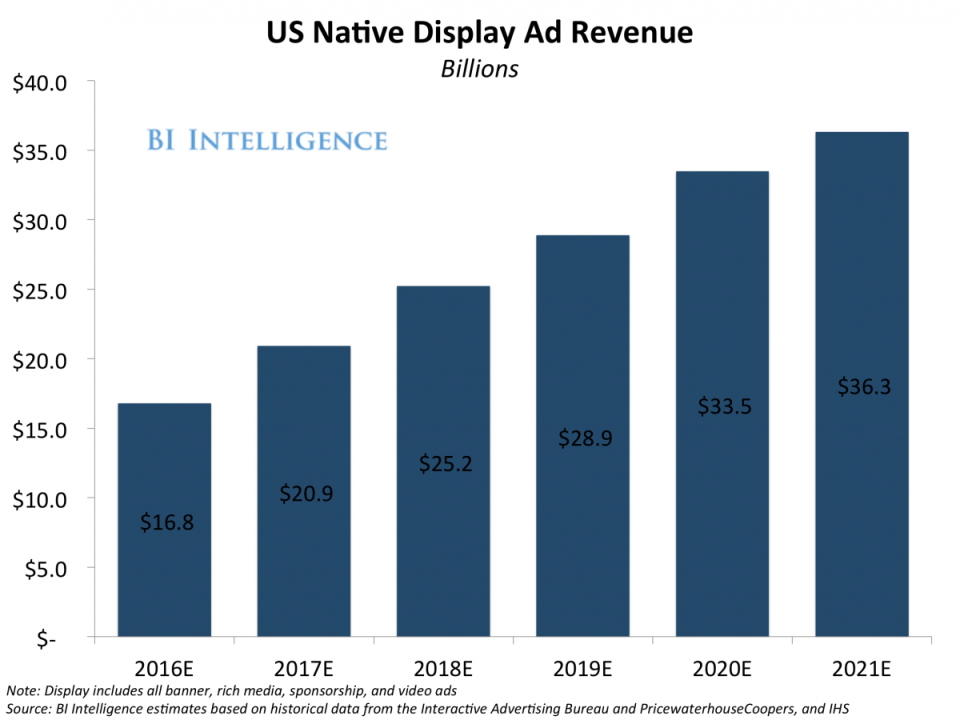Google unveils a host of new mobile ad products (GOOG, GOOGL)

BII
This story was delivered to BI Intelligence "Digital Media Briefing" subscribers. To learn more and subscribe, please click here.
Google revealed several new ad products at its Google Performance Summit Keynote, according to Bloomberg.
The Summit features the latest ads and analytics from the tech giant, specifically the company's Google Analytics and AdWords platforms.
Perhaps the most noteworthy revelation is Google's plan to update AdWords by breaking up the bidding process by device type. Through the new platform, users would be able to bid on inventory specific to mobile, tablets, or desktop, which gives advertisers flexibility in creating and targeting their campaigns. This, in turn, should increase the buying of native ads, especially on mobile.
Google also unveiled new advertising in Google Maps in an attempt to drive offline conversations and foot traffic. The tech giant is testing promoted pins and promoted locations in the mobile and desktop versions of Maps to let users discover businesses and products in their surroundings.
The company also unveiled native response ads to expand native ad inventory. This tool will resize and modify ads to fit the look and feel of the website on which they are hosted. The advertiser provides the headline, description, URL, and image for the ad, and Google dynamically builds the rest.
Finally, Google has expanded the amount of text that advertisers are permitted to use in AdWords for the first time in the platform's 15-year history. The new format allows two headlines of up to 30 characters and a description of up to 80 characters, up from a previous limit of one headline of 25 characters and two 35-character description lines. This should give advertisers freedom to get creative with their copy and help consumers make a more informed decision before they click an ad.
These native ads — or ads that take on the look and feel of the content surrounding them — are taking over digital advertising.
By 2021, native display ad revenue in the US, which includes native in-feed ads on publisher properties and social platforms, will make up 74% of total US display ad revenue, up from a 56% share in 2016, according to new BI Intelligence estimates based off historical data from the Interactive Advertising Bureau (IAB) and PwC, as well as IHS.
The rapid uptick in native's share of display ad revenue can largely be attributed to the dominance of social platforms like Facebook and Twitter — which were early champions of native and rely almost entirely on native formats — as well as the introduction of new programmatic technologies that are making it easier for publishers and advertisers to scale native campaigns.
Margaret Boland, research analyst for BI Intelligence, Business Insider's premium research service, has compiled a detailed report on native advertising that breaks out native ads into three categories: social native, native-style display, and sponsored content (also referred to as premium native). It provides forecasts for how revenues from these formats will grow over the next five years and looks at what factors, in particular, are driving up spending on each of these ad units. As a note, because revenues from these three types of native content can overlap, it does not provide an overall native forecast. Finally, it lays out some of the challenges that face properties that rely on native ads, namely ad frequency and scalability issues.
Here are some key takeaways from the report:
Native-display ads, including social native and native ads in-feed on publisher websites, will make up the bulk of native ad revenue from 2016-2021. Native display ad revenue in the US will rise at a five-year compound annual growth rate (CAGR) of 17% during this time period to eclipse $36 billion. The rise of native video ads, particularly on social platforms, will be one of the main drivers of this growth.
Social platforms generate most of their revenue from native ads and will continue to dominate overall native ad spending through 2021. The dominance of social platforms like Facebook, Instagram, Twitter, and Snapchat on mobile devices, where the entire experience is within a feed, will help propel social's contribution to overall native ad revenue through 2021.
Sponsored content, which is categorized separately from native-display due to the direct relationship between publishers and brands in creating the format, will be the fastest-growing native format over the next five years. However, the high cost to produce these ads and the limitation in inventory will limit the format.
In full, the report:
Forecasts US native ad revenue growth from 2016-2021 through three separate forecasts: native-style display, social, and sponsored content.
Identifies the major drivers of native ad revenue growth.
Discusses key players within each category that are contributing to the rise of native.
Presents some of the challenges of wide-spread native adoption with BuzzFeed as a prime example.
Lays out future opportunities for native ads, including virtual reality, messaging apps, and TV.
To get your copy of this invaluable guide, choose one of these options:
Subscribe to an ALL-ACCESS Membership with BI Intelligence and gain immediate access to this report AND over 100 other expertly researched deep-dive reports, subscriptions to all of our daily newsletters, and much more. >> START A MEMBERSHIP
Purchase the report and download it immediately from our research store. >> BUY THE REPORT
The choice is yours. But however you decide to acquire this report, you’ve given yourself a powerful advantage in your understanding of native advertising.
See Also:

 Yahoo Finance
Yahoo Finance 
